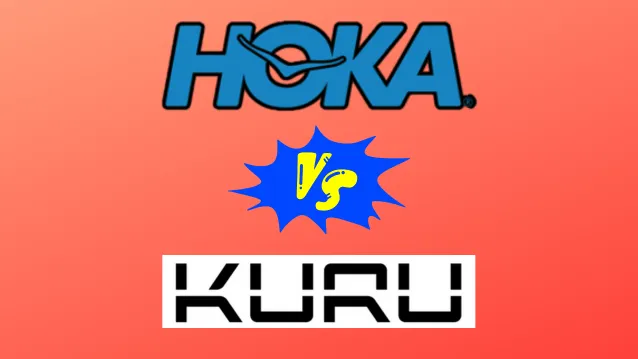Finding the right pair of running shoes can be an endless journey. With so many options on the market, it’s tough to know which brand truly delivers on comfort, support, style, and performance.
Two companies that stand out are Kuru and Hoka – but they each have distinct strengths and differences. In today’s blog post, we will analyze both brands in depth to see who is a better value for money and why.
Comparison Table Between Kuru And Hoka:
| Features | Kuru | Hoka |
|---|---|---|
| Founded In | 2008 | 2009 |
| Comfort & Fit | Excellent arch support, snug heel cup | Maximum cushioning, soft & plush ride |
| Color Options | Limited neutral tones | Vibrant color options |
| Durability | Less durable outsoles | Rubber outsoles are quite durable |
| Performance | Great for stability & pain relief | Optimized for impact reduction |
| Design & Style | Sleek, stylish athletic look | Bulky and bold design |
| Popularity | Less popular, growing brand | Very popular, existing loyal following |
| Best Selling Model | Quantum 2.0 | Bondi 8 |
Kuru Overview:
Kuru was founded in 2008 by Bret Rasmussen. After dealing with foot pain, he set out to create comfortable and supportive shoes using biomechanical research and customer feedback.

Kuru running shoes feature the brand’s proprietary F-Foam midsole. This compressed EVA foam offers responsive cushioning and durable shock absorption. Kuru shoes also have rocker-shaped soles to encourage a natural walking/running motion and aligned posture.
The star of the show is Kuru’s anatomical arch support system. It provides optimal stabilization and alignment for overpronators and those with flat feet or plantar fasciitis. The contoured footbeds are like custom orthotics built into the shoe.
Another key technology is Kuru’s heel cradle design. This stabilized cupping structure locks in the heel to prevent uncomfortable slipping and rubbing. It allows a more natural foot strike when running.
Kuru also utilizes breathable knit mesh uppers on some models like the Quantum and Atom. This creates a flexible and well-ventilated shoe. Sturdy rubber outsoles deliver traction.
Overall, Kuru running shoes are best known for their therapeutic qualities thanks to technologies like the anatomical arch support. They aim to provide pain relief and improved comfort – especially for runners with specific foot conditions and concerns.
Hoka Overview:
Founded in 2009 by Nicolas Mermoud and Jean-Luc Diard, Hoka One One burst onto the scene with their super thick midsoles, aiming to provide maximum cushioning for runners.

Initially, their oversized design was polarizing. But as more runners experienced the plush ride, Hoka gained a cult following among ultramarathoners and trail runners.
Hoka remains focused on cushioning and stability to create a smooth, comfortable run. Signature technologies like the Meta-Rocker outsole encourage a natural gait cycle and transition. The roomy toe box allows your feet to splay and relax over long miles.
For runners who struggle with joint pain and hard impact, Hoka’s pillow-like foam brings sweet relief. The soft landings and energetic rebound make each stride feel effortless. It’s easy to see why Hokas have a reputation for comfort.
Hokas aren’t the most flexible shoe due to the higher platform. And the bulky silhouette isn’t for everyone. But for runners craving a cushy feel, Hoka delivers plush shoes that can go the distance in blissful comfort.
Major Differences Between The Brands:
We’ve already seen the history of both brands. In this section, we will see how both brands compare in terms of performance performance.
1) Comfort & Fit
Kuru shoes really hug the foot thanks to their anatomical arch support, deep heel cradle, and responsive cushioning. They feel comfortable right out of the box and alleviate pain in the feet, knees, or back caused by misalignment issues.
Hoka shoes take comfort to another level with their pillow-like cloud foam midsoles. They offer a super plush and soft ride that feels like walking on air. The thick cushioning reduces the impact on sore legs and joints. However, the fit can be too sloppy for some in Hoka shoes.
Also Check Out: Sorel VS Hoka: Which Is Better?
2) Durability & Performance
When it comes to standing the test of miles, Hoka shoes edge out Kuru. The high-quality rubber outsoles have stellar traction and resilience even over long distances on varied terrain. Kuru outsoles tend to show more wear and tear over time.
In terms of performance, Kuru running shoes shine for stability and pain alleviation. Technologies like the arch support system and heel cradle provide targeted relief.
Hoka shoes excel at delivering responsive cushioning and impact reduction. The energetic foam and rockered soles make them ideal for absorbing shock on long runs and hard surfaces.
Also Check Out: Allbirds VS Hoka: Which Is Better For You?
3) Price
There’s no clear winner when it comes to price – both brands offer shoes across the spectrum. Kuru shoes typically cost $100 – $160. Hoka shoes range from budget-friendly models like the Rincon around $125 to premium pairs priced at $180+.
The technology and materials used in Kuru shoes to provide therapeutic support make them pricier than average. With Hoka, you’re paying for access to that world-renowned plush cushioning. For the features they offer, both represent a solid value at their respective price points.
Also Check Out: Hoka VS Adidas: Which Is Better?
4) Design & Style
When it comes to aesthetics, Kuru shoes have a leg up over the often clunky Hoka designs. Kuru footwear features athletic silhouettes in sleek, minimalist styles that work well for both running and everyday wear.
Hoka shoes are immediately recognizable for their extra-wide, oversized midsoles that look bulky on foot. They come in vibrant colorways but the shape lacks finesse. Kuru offers versatile, lifestyle-oriented designs while Hokas have more of a sporty, technical vibe.
Also Check Out: Dansko VS Hoka: Which Is Better?
5) Popularity
There’s no contest when it comes to brand recognition and popularity. Hoka has become one of the most renowned and best-selling running shoe brands on the market. The distinctive maximalist cushioning has earned them a huge cult following.
Kuru is still working to boost awareness and capture market share. They have a growing but much smaller fanbase concentrated in the foot health and stability niches. It may take time for Kuru to achieve the universal household name status that Hoka enjoys.
Also Check Out: Bala VS Hoka: Which Is Better?
6) Target Market
Kuru shoes cater to runners and walkers with specific foot pain and alignment issues like plantar fasciitis, pronation, or metatarsalgia. They also work well for anyone prioritizing comfort and support.
Hoka has wider appeal to all runners looking for well-cushioned shoes. Their customer base ranges from trail enthusiasts to marathoners and casual joggers. Both brands aim to reduce joint pain – just with different technologies.
Final Verdict:
In the battle of Kuru and Hoka, there is no single winner. Kuru shoes take the lead when it comes to all-around comfort, specialized foot support, stability, and style. Hoka is the champion for delivering ultra-cushioned softness and plush impact reduction.
Kuru excels at addressing alignment and pain issues in the feet while Hoka focuses on cushioning against hard impacts. Depending on your foot type and running needs, one brand may be better suited.
FAQS:
Is Hoka or KURU better?
KURU shoes are often better suited for those seeking foot pain relief and comfort due to conditions like plantar fasciitis or arthritis. KURU prioritizes alignment and shock absorption. Hoka focuses more on delivering very generous, soft cushioning but does not specialize in biomechanics.
Are KURU shoes made in USA?
Yes, KURU shoes are designed and manufactured in the United States. The company headquarters is located in Park City, Utah and they take pride in being an American brand that employs local workers to assemble their shoes domestically.
Are KURU shoes worth it?
For individuals experiencing foot pain, plantar fasciitis, knee pain, back pain or other discomfort, KURU shoes are often worth the investment because they provide exceptional comfort, support, stability and pain relief from the specialized designs and patented technologies.
What is special about Kuru shoes?
Kuru shoes utilize proprietary designs like the KURUSOLE cushioning system and Kurimazin insoles to provide comfort and support that reduces impact and promotes proper foot alignment and mechanics. The shoes are specially engineered to alleviate common foot pain points.
Can KURU shoes be washed?
Yes, KURU shoes can safely be washed by hand using mild detergent and warm water, taking care not to submerge the shoes fully in water. For deeper cleaning, they can also be washed in the washing machine delicate or gentle cycle and then air dried.
Are Kurus good for flat feet?
Yes, many of the KURU shoe models offer beneficial arch support, stability features, and motion control technologies that make them a good option for individuals with flat feet or overpronation issues. This can help improve gait and prevent excess strain.


